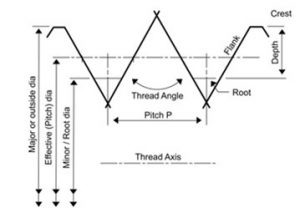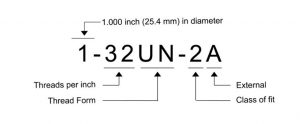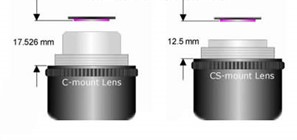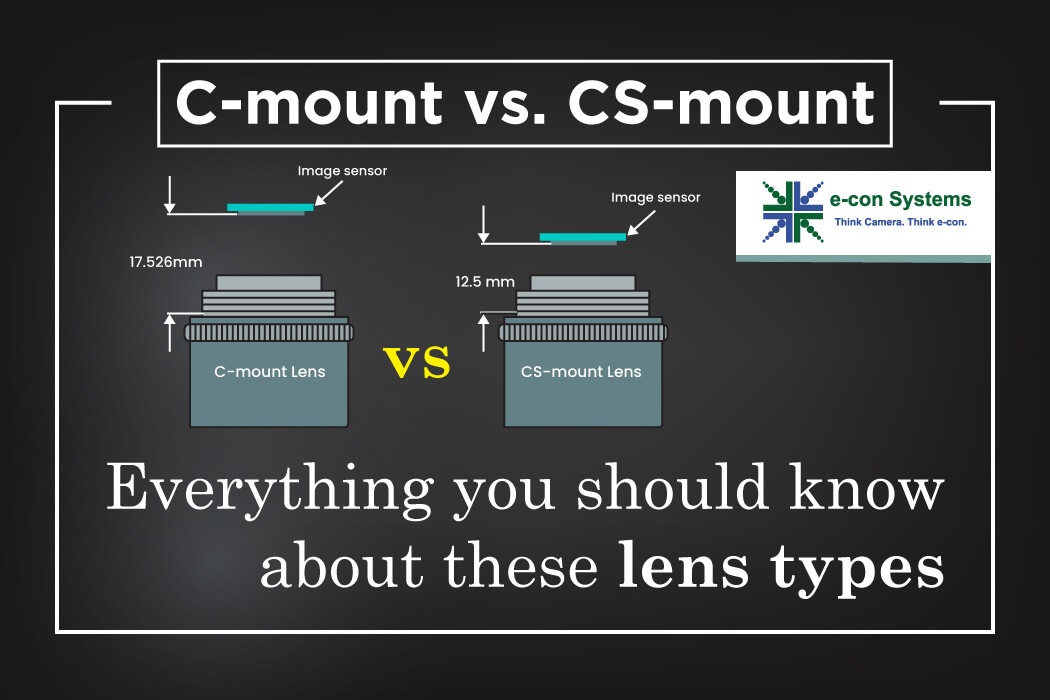In our previous article, we discussed lens mounts commonly used in embedded cameras – and all the key factors to consider while picking the best lens mount for your application.
In this article, we will be showcasing an explicit comparison between C-mount and CS-mount.
To reinforce, these mounts are mechanical devices that firmly fasten a lens to a camera body. It is of utmost importance to pay attention to even the smallest details while picking a suitable mount type for different products.
First, let’s unearth some insights on C-mount and CS-mount.
A deeper look at C-mount and CS-mount
Both C-mount and CS-mount are screw-threaded type lens mounts, which defines their mounting style. These mounts are found in most machine vision cameras and surveillance cameras.
Each mount generally differs from the other by its size, inner/outer diameters, and flange focal distance (FFD). Now, while C-mount and CS-mount almost have the same specifications, the FFD differs.
Before looking into the similarities and differences between C-mount and CS-mount, let us understand the threading specifications.
Threading specifications
Each thread in the lens mount is characterized by its pitch and diameter. The following figure shows it consists of a crest, flank, and root as the repeating features along the thread axis.
 Figure 1: Threading Specifications
Figure 1: Threading Specifications
Pitch
The pitch is the distance between the thread peaks and is expressed in millimeters. The pitch diameter refers to the diameter of the screw thread, as indicated in figure 1. A pitch of 1 means that each thread is spaced apart by 1 mm.
Major Diameter
Major diameter is the largest diameter of the thread – measured from the crest of the thread.
Minor Diameter
Minor diameter is the smallest diameter of the thread – measured from the root of the thread.
Thread Form
A thread form is defined by the standard called Unified Thread Standard (UTS). This standard designates standard thread shape along with allowances, tolerances, and designations. The UTS is commonly used in countries like the United States and Canada for screw threads.
Thread Class
A thread class refers to the acceptable range of pitch diameter for the thread. In general, a class defines how loose or tight the threads should be while mating. Thread classes are alphanumeric identifiers that start with a class number 1, as listed in the following table. These classes are followed by the letter suffix “A” or “B” for different design requirements. ‘A’ refers to external threading, and ‘B’ refers to internal threading.
| Unified Thread Class – Tolerance Range | |||
| Loose Fit | Free Fit | Medium Fit | |
| Internal | 1B | 2B | 3B |
| External | 1A | 2A | 3A |
Threads Per Inch
Threads Per Inch (TPI) is the number of threads across one inch of the thread length.
Technical Specifications of C-Mounts and CS-Mounts
C-mounts and CS-mounts are available with the specification of 1-32 TPI UN-2A” in the ANSI B1.1 standard for unified screw threads. Check out the below image for a clear understanding of this specification.
 Figure 2: Specification – C-mount and CS-mount
Figure 2: Specification – C-mount and CS-mount
The thread has a diameter of 1″ (25.4 mm) and 32 threads per inch. Both the C-mount and CS-mount have a metric thread of 25.5 mm diameter and pitch of 0.75 mm (M25.5×0.75).
Flange Focal Distance
Flange Focal Distance (FFD) is the distance from the lens mount flange to the film/sensor. It is also known as flange-to-film distance, flange focal depth, flange focal length (FFL) or flange back distance (FBD). The standard FFD of the C-mount is 17.526 mm. On the other hand, the CS-mount features a flange distance of 12.5 mm, which is 5mm shorter than the FFD of the C-mount, as shown in the following figure.
 Figure 3: FFD of C-mount and CS-Mount Lenses (Source: meijitechno)
Figure 3: FFD of C-mount and CS-Mount Lenses (Source: meijitechno)
The mount with a shorter FFD permits the lenses to be placed closer to the sensor. This, in turn, helps lens manufacturers to build simpler and less expensive short-focus lenses.
A shorter FFD also makes it easier to design compact cameras when compared to cameras with a longer FFD.
Comparison between C-mount vs. CS-Mount
Here’s a comparative table to elaborate on the technical specifications.
| Specification | C-Mount | CS-Mount |
| Inside diameter | 25.4 mm | 25.4 mm |
| pitch | 0.75 mm | 0.75 mm |
| Flange focal distance | 17.526 mm | 12.5mm |
| Camera Formats | 8mm, 16mm, 1/3″, 1/2″, 2/3″, 1″, 4/3″ | 1/4″, 1/3″, 1/2″ |
| Mount Type | Screw | Screw |
Let’s now look at the similarities and differences between C-mounts and CS-mounts.
Compatibility
Lenses create the best image when they are positioned precisely at a distance from the sensor that the optical design permits. Consequently, it’s crucial to confirm that the lens mount and camera mount are compatible.
The C-mount lens is directly compatible with the C-mount camera. It can also be screwed onto a CS-mount camera by inserting a CS-mount adapter (5 mm spacer ring) between the lens and the camera. Nevertheless, using CS-mount on C-mount cameras is not practical as the focal distance of the CS-mount is 5 mm shorter than the focal distance of the C-mount.
Generally, the thickness of the lens adapter is determined by the difference in focal flange distance.
Cost
The CS-mount lens is significantly less expensive than the C-mount since it employs fewer glass elements than the C-mount.
Sensor Size
The maximum practicable sensor size for the C-mount/CS-mount camera is 1.1″ format (17.6 mm diagonal). Moreover, the C-mount and the CS-mount are not appropriate for larger sensors, such as those found in high-resolution cameras, due to their 1-inch (25.4 mm) diameter.
Embedded vision applications that leverage C-mounts and CS-mounts
C-mount is the most common type of lens mount used in machine vision applications. It gains from having access to a huge selection of lenses. Although C-mount is the standard mount for imaging cameras, CS-mount lenses are frequently employed by manufacturers of surveillance cameras and cost-sensitive embedded vision applications. In addition, the shorter flange focal length of CS-mount lenses makes them perfect for designing affordable extreme wide-angle lenses.
Considering all the facts, these lens mounts can be paired with suitable sensors based on the targeted application.
For instance, e-con Systems’ e-CAM84_CUMI485C_MOD – Ultra-Lowlight Camera Module based on a SONY® STARVIS™ IMX485 sensor includes a CS-mount/C-mount interchangeable lens holder. It provides flexibility in selecting a lens to suit your application needs.
Some of the applications that can leverage this camera module include:
- Autonomous Mobile Robots
- Sports Broadcasting & Analytics
- Autonomous Tractors
- People Detection
- Crowd Analytics Systems
- Telehealth Devices
Cameras with different lens mounts offered by e-con Systems
e-con Systems offers a wide range of high-quality and high-performance C-Mount, CS-Mount cameras and S-Mount (M12) for new-age embedded vision applications. These lens holders support several types of lenses with varied FOVs, focal lengths, apertures, etc.
If you are interested in integrating C/CS-mount and S-mount cameras into your products, please contact us at camerasolutions@e-consystems.com. Meanwhile, please feel free to check out the Camera Selector to have a look at our complete portfolio of products.

Prabu is the Chief Technology Officer and Head of Camera Products at e-con Systems, and comes with a rich experience of more than 15 years in the embedded vision space. He brings to the table a deep knowledge in USB cameras, embedded vision cameras, vision algorithms and FPGAs. He has built 50+ camera solutions spanning various domains such as medical, industrial, agriculture, retail, biometrics, and more. He also comes with expertise in device driver development and BSP development. Currently, Prabu’s focus is to build smart camera solutions that power new age AI based applications.




